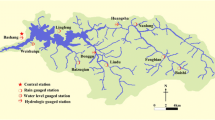Abstract
An updating technique is a tool to update the forecasts of mathematical flood forecasting model based on observed real-time data, and is an important element in a flood forecasting. The quality of the final updating results depends primarily on the quality of observed data. However, the input flow to reservoirs, or so called “observed input flow”, is usually calculated by the observed water stage, outflow, and stage-storage relation curve. In this process, coarse errors which have great negative influence on updating are often created. This paper introduces a robust theory in real-time forecasting updating, and proposes an error updating system with robust procedure to limit the influence of coarse errors. Cases of ten reservoirs are studied to test the proposed system. Results indicate that the proposed robust procedure deflates the influence of outliers. The results of real-time updating with robust procedure in flood forecasting are better than those without robust procedure.
Similar content being viewed by others
References
Bao, W. M., Ji, H. X., and Hu, Q. M. (2004). “Robust estimation theory and its application to hydrology.” Advances in Water Science, Vol. 14, No. 4, pp. 133–137 (in Chinese).
Bao, W. M., Qu, S. M., and Li, Q. S. (2005). “Study on estimation methods of rainfall gauge errors in remote system.” Journal of Hydraulic Engineering, Vol. 4, No. 32, pp. 30–35.
Bao, W. M., Zhang, X. Q., and Yu, Z. B. (2011). “Real-time equivalent conversion correction on river stage forecasting with Manning’s formula.” Journal of Hydrologic Engineering, Vol. 16, No. 1, pp. 1–9.
Bao, W. M., Qu, S. M., Huang, X. Q., Hu, Q. M., Zhao, C., and Ji, H. X. (2003). “Analysis of robust weighting functions for hydrological systems.” J. T singhua Univ, Vol. 43, No. 8, pp. 1127–1129.
Barnett, V., and Lewis, T. (1994). Outliers in statistical data, 3rd Ed., John Wiley, Chichester, UK.
Box, G. E. P. and Jenkins, G. M. (1976). Time series analysis: Forecasting and control, Holden-Day, Oakland, California, USA.
Broersen, P. M. T. and Weerts, A. H. (2005). “Automatic error correction of rainfall-runoff models in flood forecasting systems.” Instrumentation and Measurement Technology Coference, May 17–19, Otawa, Canada.
Eleftheriou, E. and Faleoner, D. (1986). “Traeking properties and steady-state performance of RLS adaptive filter algorithm.” IEEE Trans. ASS, Vol. 34, No. 5, pp. 1097–1109.
Goswani, M, O’Connor, K. M., Bhattarai, K. P., and Shamsedlin, A. Y. (2005). “Assessing the performance of eight real-time updating models and procedures for the Brosna River.” Hydrology and Earth System Sciences, Vol. 9, No. 4, pp. 394–411.
Han, J. W. and Kamber, M. (2001). Data mining: Concepts and Techniques, Morgan Kaufmann Publishers, USA.
Haykin, S. (1996). Adaptive filter theory, 3rd Ed., Prentive Hall, NewYork.
Hu, S. Y. (1987). “Problems with outlier test methods in flood frequency analysis.” J. Hydrol., pp. 375–383.
Huber, P. J. (1981). Robust statistics, John Wiley, New York.
Karhunen, J. and Pajunen, P. Oja, E. (1998). “The nonlinear PCA criterion in blind source separation: Relation with other approaches.” Neurcomputing, Vol. 22, No. 1, pp. 5–20.
Li, R. R. and Wu, G. X. (2008). “Research on the robust correction method of a reservoir’s input flow.” China Rural Water and Hydropower, Vol. 11, pp. 12–14.
Poor, H. and Wang, X. D. (1997). “Code-aided interference suppression for DS-CDMA communications, Part 11: Parallel blind adaptive implementations.” IEEETrans. Comm1, Vol. 45, No. 9, pp. 1112–1122.
Qu, S. M. and Bao, W. M. (2003). “Comprehensive correction of real2time flood forecasting[J].” Advances In Water Science, Vol. 14, No. 2, 167–172.
Rey, W. J. (1977). Robust statistical methods, Springer, New York.
Toth, E., Montanari, A., and Brath, A. (1999). “Real-time flood forecasting via combined use of conceptual and stochastic models.” Physics and Chemistry of the Earth Part B, Vol. 24, No. 7, pp. 793–798.
Zhao, C., Bao, W. M., and Hong, H. S. (2009). “The robust detection of outlying rainfall observation.” Hydroinformatics in Hydrology, Hydrogeology and Water Resources, pp. 154–162.
Zhao, C., Hong, H. S., Bao, W. M., and Zhang, L. P. (2008). “Robust recursive estimation of auto-regressive updating model parameters for real-time flood forecasting.” Journal of Hydrology, Vol. 349, No. 5, pp. 376–382.
Zhao, R. J. (1992). “The Xinanjiang model applied in China.” Journal of Hydrology, Vol. 135, No. 16, pp. 371–381.
Zhao, R. J., Zhuang, Y. L., Fang, L. R., Liu, X. R., and Zhang, Q. S. (1980). “The Xinanjiang model.” Hydrologica Forecasting Proceedings Oxford Symposium IAHS, Vol. 129, No. 7, pp. 351–356.
Author information
Authors and Affiliations
Corresponding author
Rights and permissions
About this article
Cite this article
Qian, L., Weimin, B. & jinglin, Q. An error updating system for real-time flood forecasting based on robust procedure. KSCE J Civ Eng 19, 796–803 (2015). https://doi.org/10.1007/s12205-013-0483-x
Received:
Revised:
Accepted:
Published:
Issue Date:
DOI: https://doi.org/10.1007/s12205-013-0483-x




